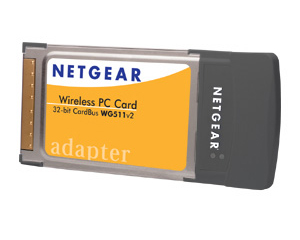
Mobile Data
This article, originally written around 2004 and updated since, is a quick description of various options for achieving internet and fax connectivity while travelling. As a private pilot, I have had to get this sorted early on because preflight planning is now almost entirely internet based. One needs to be able to get weather and other information, file flight plans, send faxes to airports to get landing permits, etc.
There are various ways to do most of the functions described, and this is just a short overview of the technology at the user end.
Business executives who travel a lot and are well supported by their employer will not have much of a problem. There are many "business" packages for mobile connectivity, based around GPRS/3G contracts. Many executives will be carrying a Blackberry or similar and will have constant data connectivity. However, this article deals with the "intermittent usage" scenario which is much more applicable to a private traveller.
A simplified and updated article on mobile connectivity is here.
Ethernet
This is the one most likely to "just work" and some hotels provide it, usually free of charge. It is a socket in the wall and you need an RJ45-to-RJ45 cable to your laptop. Nearly every laptop has an Ethernet connection. The speed will be the full speed of the hotel's connection; usually this is ADSL or similar. The configuration on the laptop is as trivial as it can be; most come preconfigured to automatically detect the connection and there is nothing else to do. Just plug the cable in...
If you cannot get an Ethernet connection, then you need one of the wireless options below.
WiFi
This is a short range wireless high speed connection, fairly widely available in hotels, cafes, etc. Unless the provider is playing silly games and throttling the data rate, Wifi gives you full broadband speed (just like an Ethernet cable connection) so this is the internet connection of choice - if you can get it.
Wifi is also called "802.11" with a suffix of "b", "g" or others according to the speed that is supported. In fact, any of the speeds (the slowest being 11 megabits/second) is way faster than any connection you are ever going to get to the internet. Most new laptops come with a WiFi adaptor inside, in which case there is no need to get anything else.
Most laptops made in the last few years have WiFi built-in. For older laptops, several solutions exist, connected via PCMCIA (nowadays called "PC Card"; shown below) or USB. My favourite PCMCIA card is the Netgear 511 which I have found to work very reliably especially on the more secure connections using WPA or WPA2. You can find these on Ebay very cheaply. Make sure you have the latest software for it (from their website).

To set up WiFi connectivity using a WiFi card like the one above, you install the software, plug in the card, and a network connection appears which looks just like an ethernet (cable) connection. With Wifi there is no telephone number to dial, but, depending on the security setup of the access point which you are connecting to, you may need to enter a password. Most of the chargeable connections in hotels etc do not use a password (they authenticate you using various other means e.g. cookies or the MAC number) but internet cafes tend to use passwords, which you purchase.
One of many USB adaptors is shown below
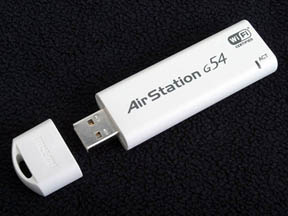
The disadvantage of these USB adaptors is that they need to be removed when travelling (otherwise they will break off) and some old laptops have only one USB port, leaving no spare ports for e.g. a mouse. As a general observation, network connections over USB are more complex (at the Windows level) than using PCMCIA, and PCMCIA adapters are thus generally more reliable and their software works better. USB uses a flimsy connector which is easy to break, while a PCMCIA card can be left plugged in permanently.
Wifi security can be set up at various levels and you will need to set it up according to the access point which you are connecting to. The following is a summary of the options:
WEP Encryption. This can be 64-bit or (unusually) 128-bit. It is just a password you enter, either into the Wifi adaptor's software or into Windows' Wireless Networks feature if using a built-in Wifi adaptor.
WPA/PSK. This is common in domestic situations but is less common in public access points. There is still a password but it can be a long phrase. WPA is far more secure than WEP but that hardly concerns you when you are just after any old connection that works! There is a modern variation called WPA2 which uses AES encryption (WPA/PSK uses TKIP encryption) but the principle is the same. Older laptops may not support WPA, and quite a few don't support WPA2, although software patches can sometimes address this.
WIFI availability: There has been a great deal of press hype about how widely WiFi is available, but the reality is that is works over a short range (tens of metres) and you can't rely on getting it when you really need it. Unsecured Wifi used to be common, and it is still common in residential areas (due to peoples' ignorance), but businesses are now well aware of the issues and most access points in city centres, cafes, etc, are secure. Those intended for public use are invariably charged for and often steeply. The credit card billing options are often rather suspicious, with automatic repeat billing which will not stop until you ask them to stop... Moreover, a lot of the providers which hotels and other establishments routinely set up deals with attempt to prevent abuse of the bandwidth, with various measures like bandwidth throttling (which is usually not a problem) or TCP/IP port blocking (which can be a problem because it stops some applications working over the connection). Many cafes with free wifi do remain but can take a lot of hunting down.
When a WIFI connection is charged for, it is usually implemented as an apparently free connection; the laptop discovers it and connects to it immediately. But.... it doesn't connect to the internet. No email connectivity, for example. It is only when you start up a web browser and go to some (any) website, some service provider's web page appears asking you for your credit card details. Then, when you've paid, you get a "normal" internet connection, for X hours. Regular travellers can purchase long term passes with common networks such as T-Mobile but I have found the availability of any given network to be too sporadic to be of much use in Europe.
The most annoying, and unfortunately common, situation is when you check into a hotel which has free internet access, they give you the password, and it doesn't work. So you try to enter it as WEP (64- and 128-bit), WPA/PSK, WPA2, as ASCII, as hex, and every other imaginable combination, and the staff doesn't have a clue.... Which brings us to GPRS or 3G - below.
The WIFI scene is becoming wholly commercial. I found, during a 1-week trip to Greece in 2011, that every single usable access point was a commercial one, and every residential one in the vicinity was secured. Obviously, the company operating the commercial ones went round the neighbourhood and got all the homeowners to secure their routers...
GPRS/3G
This is the most mobile of the options. It uses the Europe-wide (nearly worldwide, in fact) GSM mobile phone network. The following discussion is based on pay-as-you-go (PAYG) SIM cards, rather than contract (pay monthly) SIM cards, unless otherwise stated.
The billing is done per kilobyte and on PAYG there is no free allowance. The tariffs can be pricey but there is considerable variation between networks. Recent EU regulatory action has forced a reduction in roaming tariffs but the companies are slow to do anything and if they do drop prices they cheat by dropping them only for some customers and not others (by running multiple APNs - the same game banks run, to lock customers into old accounts which pay less interest).
From the user's point of view, GPRS and 3G are identical except for the speed and geographical coverage. The cost per kilobyte is usually identical. GPRS coverage is practically identical to plain GSM (voice call) coverage. 3G coverage is poor outside large-city areas and a normal GPRS/3G "modem" normally falls back on GPRS when it cannot find 3G. The fallback happens automatically, if appropriately configured. 3G coverage is slowly improving.
One can achieve a connection using several methods. One is an internal adaptor (which can be a PCMCIA card like the one shown below, or a module mounted inside a laptop); another is an external USB adaptor; another is using a conventional mobile phone as a "modem". In the latter case, the phone needs to be data-capable (most of the better ones are) and is connected to the laptop using either a USB cable or a bluetooth connection. The big advantage of using a mobile phone as the "modem" is that the billing goes onto the SIM card in the phone, and if the phone is provided by your employer then you have a very good deal :) Another advantage of using a phone is that it can be placed on the window sill for a better signal, while you work on the laptop elsewhere in the room.
GPRS/3G via a PCMCIA adapter
A popular but now rather old GPRS-only PCMCIA card which also supports fax is the Sierra 750 which can be picked up on Ebay very cheaply
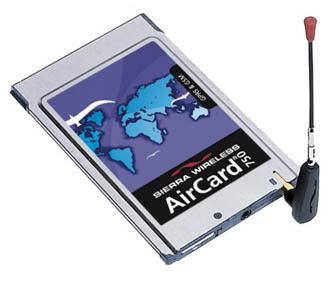
It doesn't do 3G but it does support outgoing and incoming fax, using Winfax. The most recent driver software for the Sierra 750 is here (6MB).
A lot of detailed notes on the Sierra 750 and GPRS generally are in this article which deals with a particularly messy installation inside a ruggedised tablet computer. However, simply using one of these with a laptop is easy: install the Sierra 750 Card Watcher software, pop the SIM card into the adapter (most are not network provider locked - not even the Vodafone badged ones), and away you go. The card finds a network, and you click on the Connect button in the Watcher program. This gives you a windows "network" connection - not the more troublesome "dial-up" connection.
Another data card which does both GPRS and 3G is this widely badge-marketed "GlobeTrotter" one
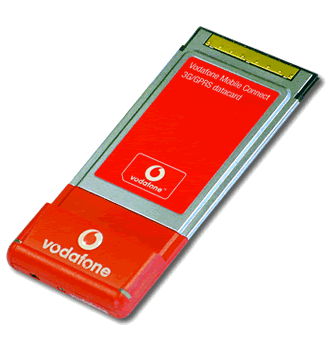
which is made by Option. This one doesn't support fax but that isn't going to worry most users (see below under Fax).
The drawback of the above PCMCIA adapters is that many modern miniature laptops do not have a PCMCIA slot. They also stick out of the laptop a little; not a lot can be done about that other than getting a corporate-grade laptop which has the GPRS/3G radio built-in.
GPRS/3G via a USB adapter
There are a number of these around and here are a few, randomly found on Ebay around the £50 mark
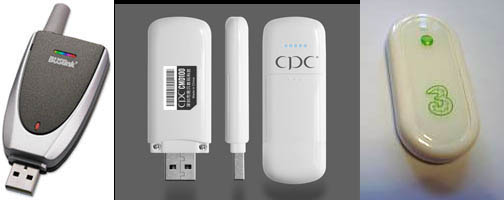
Most of the above are network provider locked, but can be unlocked using DC-Unlocker. However, it pays to pay a bit extra to get one which is unlocked.
GPRS/3G built into the laptop
There are laptops which have the GSM/GPRS/3G radio built in; I use a now rather dated Thinkpad X60S 1704. With built-in wifi as well, this provides virtually universal internet connectivity. These built-in radios are usually network provider locked - usually to Vodafone which is the most expensive option - but can be unlocked using DC-Unlocker above.
This is a neat solution which avoids "gadgets" but since the SIM card is now hidden inside the laptop (it is usually quite easy to get to it) you now have the administrative task of keeping it topped up (if PAYG) or paying a monthly payment (if contract) regardless of usage. For heavy users, contract is the best option - especially if somebody else is paying :) However, sporadic data users need to deal with the network's blocking of PAYG SIM cards after 3-6 months of no activity, and at least send an SMS with it every few months.
WIFI via GPRS/3G This is an interesting twist whereby if you have a
cheap GPRS/3G connection, with a cheap and simple device you can get
a WIFI access point which is then usable by any WIFI capable device. This can
be priceless for mobile data while abroad, when roaming data is normally very
expensive. One solution to the cost is to buy a local SIM card, which will normally
provide very cheap internet data, and is worth doing if staying in the same
country for more than a few days. Unfortunately if you put this SIM card into
your phone, your phone number changes and this makes the phone effectively useless
for phone calls... It can still be used for outgoing calls... until somebody
stores the caller's number in their phonebook ![]()
There are several products on the market which are basically GPRS/3G to WIFI routers; e.g. the Huawei E585
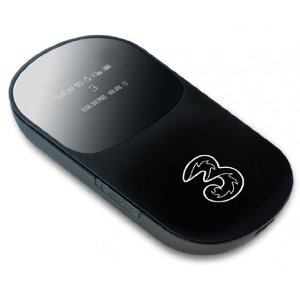
This is a tiny device; about 3.5" in length, and is charged via a USB cable. Most of these are sold network-locked to the UK "3" network, which is useless for a pilot travelling outside the UK. If you get an unlocked one (about £60 from Amazon.com) then any locally purchased SIM card is simply inserted into it, and you should get WIFI. The WIFI is encrypted with WPA (the password is enclosed in the package) which prevents other people using the connection.
This is a great solution to the shortage of WIFI coverage which is now a widespread problem. Even in hotels, where you would expect WIFI to "just work", it is not uncommon to get a poor signal, or the password doesn't work and the staff cannot sort it out, etc.
Beware: these products usually detect and set the APN automatically, and this fails with some networks (e.g. T-Mobile); one has to login into it on http://192.168.1.1 and configure the APN manually.
Another way to achieve the same function is to use a mobile phone which has GPRS/3G/WIFI connectivity and use Joikuspot to convert it into a GPRS/3G to WIFI router. This avoids carrying yet another "box" but you still lose your phone number while the local SIM card is in the phone.
Some countries block the use of a local SIM card with a non local IMEI i.e. a non locally purchased "phone" product. This is to generate revenue for domestic phone businesses - by forcing visitors to either run expensive roaming, or to purchase a phone locally. Known cases are Turkey and S. Korea.
Whose SIM card / Which network provider ?
Very little clear guidance is possible here. For voice usage, there isn't usually much to choose between the various networks unless one is regularly making specific types of calls. Obviously, a light user should be on PAYG; a heavy user should be on a contract, and if you spend a lot of time in a particular country then you should purchase a SIM card from a local network there. Foreign SIM cards can be purchased from the UK, from sites such as this one. One could be a real anorak and put together a price matrix of the various networks but it would take for ever and would need updating almost daily.
For data (GPRS/3G) there are some huge pricing differences; especially relevant on PAYG where the rates are all steep. Vodafone (2009) charge around £10/MB when roaming (i.e. abroad) but offer tariffs which are capped at £10/day. Virgin (2009) charge £5/MB for both UK and abroad. T-Mobile charge £1.50/MB for what appears to be the EU and £7.50/MB elsewhere. For the UK (non-roaming) most UK networks now offer various deals e.g. 30p/day for up to 25MB/day (Virgin); £2/day with a 2GB monthly limit (T-Mobile) and these are so cheap that the cost of data is barely significant when within the UK. On contracts, costs of data vary widely but in some cases you get massive free monthly data allowances (in the UK) or much smaller but still useful allowances (when roaming outside the UK) when on a contract with a substantial monthly payment. There is a great lack of transparency on roaming charges and while the networks clearly publish costs for voice calls abroad, most go to great lengths to avoid spelling out the cost of roaming data.
March 2010: The EU action to limit billing to 50 euros/month (or a higher limit if agreed with the customer), effective 1st March 2010, and apparently intended to curb the incidence of huge bills (numerous £10,000+ bills for roaming data have been reported) has been cynically exploited by most networks. Because - as a result of EU rulings - they have for some time been losing revenue from high volume users, they have taken advantage of this new directive and implemented new billing policies which force the purchase of a "bundle"; e.g. £4 for 1 hour. On a per-MB basis these bundles are much better value than the previous per-MB billing, but the networks are correctly banking on most users wasting much of each bundle, which of course they must because nobody wants to get cut off during a session. For example, Vodafone's business support department told me that with the downward pressure on prices "something had to give". At time of writing (6th March 2010) the least bad one is T-Mobile, with a £1 minimum bundle size (lasts 24hrs), and a reasonable £10/1month/50MB bundle. However, all the networks have created a problematic situation because you will have to go to a website (or send an SMS) to purchase the bundle at the start of each day/month etc. Simply going online and collecting emails etc does not work anymore; the connection works for a few seconds and then is cut off, and you get an SMS offering the bundle purchase options. They could have implemented the EU directive simply by getting each user to agree to some limit, and disconnecting him when this is reached, but that would not have generated the additional revenue resulting from unused bundles. Remember also that this new "scheme" applies only to the EU; if an EU resident, using an EU SIM card, visits e.g. Croatia (non-EU) then a contract user can run up that £10,000 bill just as before.
All the networks try hard to differentiate their contract / PAYG products, presumably to prevent light users who are on contracts (which applies to a lot of corporate users with company-issued mobile phones) migrating to PAYG. So PAYG facilities are crippled in various ways. Vodafone do the least amount of functional crippling but tend to be the most pricey. Some providers tend to cripple functionality, by blocking fax, blocking some TCP/IP ports, in extreme cases blocking all TCP/IP ports except WAP, etc but this is less common nowadays. All providers offer reduced geographical coverage on PAYG; a part of the reason is a genuine technical issue with billing systems.
In the past, PAYG was routinely crippled by a refusal (or great difficulties) in transferring one's phone number from one network to another, but this practice has ended (in the UK). However, if you use a SIM card for data only, it doesn't matter what its number is anyway, unless you use it for receiving faxes (which is highly unlikely).
PAYG is nearly always crippled by the network operating a separate call centre, located in India or some other place and staffed with "script monkeys". These call centres can drive one bonkers. Contract users usually get a different number to call, which leads to a UK call centre where the staff may not know a lot more but at least one can understand them, and they have a backup for getting answers.
Vodafone and T-Mobile seem to offer an internet connection with no port blocking that I am aware of. Most other providers block Windows VPN (PPTP) ports and probably many others; this won't bother users whose internet access is limited to web browsing (HTTP port 80, or HTTPS port 443).
Watch out: GPRS/3G networks mess with images within the data. When you access a website, you are accessing it via the network provider's www proxy server, and this server compresses any images within the page. On the face of it they are doing you a favour by reducing the amount of data transferred, but the compression can be rather severe and the loss of image quality is significant. This compression cannot be disabled, but you can prevent it by accessing the website in a manner which avoids the network's proxy server. The simplest way is to use a 3rd party data compression facility which offers user-selectable levels of compression; the best known one is Onspeed but there are many others. There is a discussion on data compression which is implemented by Vodafone and probably most other network operators, here. For anyone using GPRS/3G data abroad (roaming), Onspeed is worth getting anyway for the data compression alone which averages around 5x and this represents a huge financial saving.
Watch out: Disable automatic software updates, etc, otherwise you can get a huge unexpected bill for the data. Programs that do auto updates include: Windows, antivirus software, Firefox, Adobe reader/writer, Java. If you get caught out by some of these while abroad (roaming) on a fast 3G connection, it can wipe out a £50 SIM card prepayment in not many minutes, and I have done this a few times.....
Onspeed "special offers": The Onspeed driver accesses the Onspeed server to check for updates, whether the subscription is valid, etc. Unfortunately Onspeed runs a highly dubious scheme whereby you get a pop-up with a special offer of renewing the subscription, which is tempting but you get this even if you have renewed very recently!! If you have forgotten that you have recently renewed you end up paying again. I have tried hard to extract from them why they are doing this and after many attempts managed to get an evasive reply saying it is only a special offer which you are free to ignore. So, keep track of when you bought the subscription and how long for, and ignore the special offer pop-ups until you need to renew...
Currently (2010) both my Nokia phone and my Thinkpad laptop's built-in GPRS/3G radio use T-Mobile. I moved from Virgin (which funnily enough runs on the T-Mobile network) the day Virgin implemented their ripoff £4/hr bundle deal for roaming data. They did it on a day I was abroad...
PAYG Topping-Up Options
Top-up Card: you present this in a shop, with a payment, and the money gets credited to the card account. With UK-network cards this is claimed to work around Europe but in reality it rarely does.
Internet Top-up: this involves setting up a website account for the SIM card. You also register a credit card on there. You can do the top-up from anywhere where you can get an internet connection. Beware though: the websites are not designed to be efficient and if you are doing this over GPRS/3G you can easily spend a few Pounds/Euros in data charges just doing the topup! Virgin and T-Mobile have the slickest topup websites; Vodafone and Orange are dreadful and full of money-wasting graphics. This kind of thing is best done from home, or an internet cafe.
Top-up Voucher: you buy this in a shop, and enter the code printed on it into the website account mentioned above. Alternatively, it can be done with a phone call but this likely requires the SIM card to be in a normal mobile phone, to make the call.
Phone Call: You phone up the network and pay using e.g. a pre-registered credit card.
SMS: Send a text message to a certain number, containing stuff like the topup amount and the last 4 digits of a (preconfigured) credit card. T-Mobile offers this.
Fax
Not a lot of people use fax these days, but it remains very useful for private aviation purposes. Most airports are either not on email, or they never read it, or the email address is not published. Travelling internationally, one often can't speak the local language so a phone call can be difficult, but a written communication in English will eventually get taken to somebody who can read it. A fax facility makes it very easy to send the UK GAR form to all three numbers, with very little effort, without having to worry about which of the three was missed out for the particular airport.
There are two ways to send faxes from a mobile laptop: a GSM fax modem, and via an internet connection using an email2fax/fax2email service.
GSM fax runs at the standard GSM fax speed of 9600 or 14400 baud and many of the GPRS/3G adaptors support it. Some networks block fax on PAYG, permitting it only on their "business" contracts. However, Vodafone and Virgin support outgoing fax. Vodafone supports incoming fax too, but you have to contact them to get a separate number assigned for the incoming faxes and of course the laptop has to be switched on all the time you are expecting incoming faxes.
The typical software running on a laptop is the now-discontinued Winfax (originally developed by Delrina and later bloated and nearly messed up by Symantec) and I use version 10.02. It takes some setting up to get it working in a mobile/laptop context, it stops working inexplicably, and I thus cannot honestly recommend this method of sending faxes. The one advantage of sending a fax directly is that sometimes it is nice to see the actual progress (or lack of progress) of the call; for example if the number being called is in fact a voice line, you can hear the person answering whereas an email2fax service will just keep failing and you will never find out why. A further drawback is that fax operations need a rock solid maximum-strength mobile phone signal otherwise the pages get corrupted, or the connection can drop down to a very low speed (say 2400 baud) and cost a lot of money.
With an email to fax gateway, to send a fax, you send an email to a specific email address. The text of the email gets converted to a fax page, and any attachments (specific formats only allowed e.g. TIFF, PDF etc) get converted to subsequent fax pages. Because "somebody" has to pay for the eventual fax transmission, these services all have a prepayment web account. One such service is Interfax and there are many of them. Even if the internet connection is an expensive PAYG roaming one, the total cost of the email and the eventual fax charge is probably lower than sending a fax via GSM directly (Winfax, etc).
To receive a fax, you do have some totally free options with 0870 and similar numbers (10p/minute or so, paid by the sender) and the charge to the sender finances the service. But you need to ensure the number can be dialed from abroad!! Personally I use Inweb who offer a fax2email service with - for a reasonable annual charge - geographical numbers e.g. 01444-xxxxxx - these are "nice" and can always be dialled from abroad. Unfortunately Inweb don't do the other direction - email to fax - and for that I went to Interfax above.
Not many people nowadays will be doing GSM fax with a laptop, preferring to use email2fax or fax2email services which merely need an internet connection, and don't need the laptop to be continually switched on to receive faxes. The additional plus of using the internet is that one can get usable internet access with a much poorer GPRS/3G signal than one needs for an error-free GSM fax transmission.
Satellite Data
This has been around for some years but has been very expensive - the exclusive domain of 6- and 7-figure yachts and executive jets, with £10/minute calls etc. But a lot has changed in recent years. Iridium changed things a bit but is still pricey; it does however offer a worldwide coverage. Thuraya is the real new offering with a "GPRS"-like service on PAYG for $5/MB which is generally below the GSM cellular providers' GPRS/3G roaming rates! Well, when it works... Their 9600 baud dial-up service is quite solid though. One can also do fax calls, and suprisingly Winfax does work with the old Thuraya/Hughes 7100 phone.
The advantage of Thuraya is that it works anywhere within the satellite coverage area (Europe, plus a huge margin around it). The disadvantage is an even lower connection reliability than GPRS/3G, and a requirement for the satellite phone to be on a line of sight to the satellite. It does not work indoors unless you can find a window looking out to the South East (in Europe) from which Thuraya's geostationary satellite can be seen directly.
It took me only minutes to configure my Thinkpad laptop to connect, via Bluetooth, to the Thuraya SG-2520 satellite phone. Sounds too good to be true, especially for Bluetooth? Well, yes... after installing the Windows XP SP3 update (which has become so notorious in killing PCs that Micro$oft have had to offer a free telephone support service for it) the Bluetooth connection stopped working and the only way to get the satellite phone back was to use it via its USB cable.
Some notes on satellite internet are here.
Page last updated 8th July 2011.
Any feedback, reports of dead links, corrections or suggestions much appreciated:
Contact details